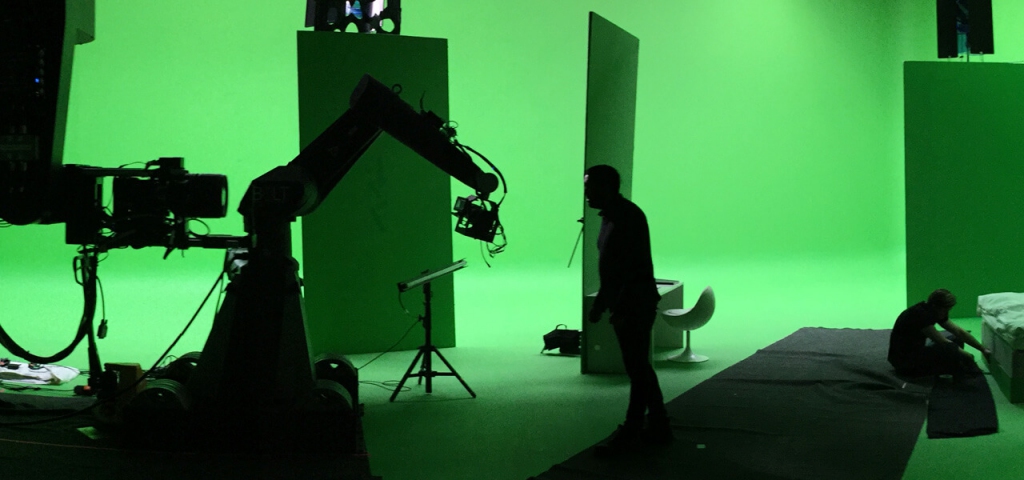Chroma Key Technology: Guide for Filmmakers
Whether you are a VFX producer, manager, or intern, you’ve probably heard about chroma key technology. It’s something that is used not only in just about every movie these days but in music videos and social media content too.
If you already have experience with chroma key or it is something completely new to you, the following guide for filmmakers should help explain the concept to you. Read on to find out more!
What is chroma key technology?
Whilst the term chroma key may not be too familiar to most people, they are probably aware of it in different terms - green screen. Green screen technology is a form of chroma key, and can be dated back all the way to 1940!
Chroma keying essentially describes the process of shooting a subject with a colored background, using this background for chroma key as a "green screen" or "blue screen". The bright color surrounding the subject is removed, giving editors the freedom to replace the pixels with an alternative backdrop such as an alien landscape or an action shot.
For this reason, it's used in just about every film these days to put film subjects into environments that cannot physically be shot in. However, due to the simplicity of the technique, the chroma key effect has become exceptionally popular on social media, with almost everyone using platforms such as TikTok and Instagram being familiar with the technology.
Best chroma key colors
As mentioned earlier, green is by far the best chroma key color to work with. This is due to the color's high luminosity, making it easier than many other colors for editors to remove with ease. However, this does not mean that it is the only color that can be worked with.
Behind green screen footage, the second most popular chroma key technique is the blue chroma key, another high luminosity color. However, you may be wondering why other high luminosity colors such as red are not used. Well, it is because green and blue are colors that are not found in the human skin, meaning that there is no chance that chroma key effectS may accidentally remove parts of the subject.
Therefore, despite any solid color such as white, orange, brown, and yellow being viable chroma key backgrounds, they are less commonly used due to appearing in skin tones. However, these colors may still be suitable for non-human subjects.
A final thing to consider when choosing a chroma key color is the clothes that the subject is wearing. Whilst a chroma key green screen may seem like the most obvious choice, this isn’t going to be useful if an actor’s outfit is green. In this event, a contrasting color is most appropriate, such as blue.
VFX and chroma keying
When you’re a member of a VFX pipeline such as VFX producer Max Colt of FRENDER, you will find that chroma keying is a technique that must be used on an almost daily basis. This is due to the fact that chroma keying is most commonly used in combination with CGI.
Why is this exactly? Well, it’s because chroma keying allows VFX producers to put their subjects into environments and situations that they otherwise could not be in, and that is basically the definition of VFX.
If a filmmaker envisions their lead character exploring an alien world or an ancient unexplored civilization, this will first be designed by VFX artists, before being passed down the VFX pipeline to a VFX producer. This would also be the case for smaller VFX subjects such as lasers being fired from a weapon, explosions, weather, and just about anything else.
Ultimately, VFX and chroma keying go hand in hand, as they both allow filmmakers to produce moments that would otherwise not be possible.
Chroma key compositing
Sometimes, the term "chroma key compositing" is used within the context of pipelines, and this can cause some confusion. However, it is actually quite simple - it is essentially the longer way of describing the chroma key process.
Many people use this term to differentiate between general chroma keying and green or blue screening. Ultimately, it is simply the technique in which two images or film frames are mixed together, through the process of removing color from one image and thus revealing another image behind it.
How to set up Chroma Key correctly
Now that you are aware of what chroma key is and why it is so commonly encountered within the VFX industry, you might be how you might go about using the technique yourself. Well, the VFX team at FRENDER is happy to help – read the following step-by-step guide on how to set up chroma key correctly, and you’ll be using it in your productions in no time!
Step 1: Consider the Purpose of your Chroma Key shot
The first step to chroma keying correctly is to consider why you are doing it in the first place. What sort of scene are you trying to achieve? Are you trying to place the main character of your film into a CGI spaceship, or are you simply trying to mix two different backgrounds together? Take a while to consider this, as it will determine how you will need to layout your shot.
Step 2: Prepare your Chroma Key Background
Once you have figured out what purpose chroma keying will hold in your VFX production, it’s time to prepare the content for the scene. This could take a while depending on the complexity of the content, so it’s important to plan the previous step ahead within suitable time!
Step 3: Consider what Colours your Scene will Include
You will now need to refer back to the section of this guide on chroma key colors. Consider what colors will be used within your scene – ask yourself the following questions. What color will the main subject’s outfit be? Do you have a variety of color screens to work with or only a green screen? This will be very important in determining the success of your chroma keying, so choose wisely!
Step 4: Set up the Screen
You should now be ready to set up your chroma key screen and start filming. You should take extra care in ensuring that everything is perfect at this stage. Make sure the room is well lit, and that there is no inconsistent lighting or coloring on the screen. Make sure that it is completely flat, and that there is no wind or drafts that is going to compromise its steadiness.
Step 5: Film your Shot
It’s now time to start the filming process. You will need to ensure that your actors or subjects are suitably framed within the colored screen. Make sure they don’t do anything silly like bump into it or show any awareness of it, as this would break the VFX illusion!
Step 6: Editing the Chroma Key Shot
You should now have your chroma key footage ready to be edited. Simply import your shot into a chroma key software, and get to work. If you completed Step 4 correctly, this shouldn’t be too much work. However, if there was any inconsistency, you may have to do some manual chroma keying in post-production.
Best chroma key software
Back when chroma keying was first invented in 1940, filmmakers were actually achieving the technique through film reels alone! It was a painstakingly frustrating and time-consuming process, but thankfully we have software these days to handle the heavy work.
When it comes to industry-standard chroma key software, you will generally be looking at accessing Adobe After Effects. This software is excellent for all kinds of VFX production and post-production and features a specialized chroma key editor for seamless chroma keying. Furthermore, it integrates within other Adobe filmmaking software such as Premier Pro, facilitating seamless chroma key workflows.
Another solid choice is PowerDirector, particularly for Windows users. Whilst this software is perfectly capable of achieving chroma key techniques in the same way as After Effects, it must be said that it can feel a little clunky and frustrating to use at times.
Many producers will also swear by Final Cut Pro X for chroma keying. Once again, this is decent software and can definitely achieve the technique, but it is also a bit more rudimentary than After Effects and PowerDirector. It’s also only available for Mac users, so Windows users will have to look elsewhere.
Whichever software you choose, chroma-keying is thankfully a lot easier than it was back in 1940. There are even in-built chroma key tools on mobile video editing software these days. Whichever method you choose, we wish you good luck, and don’t forget to choose your chroma key color carefully!





_1024x0_d94.jpg)
